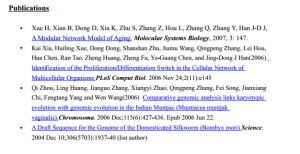
Efficient Online k-mer Counting using a Probabilistic Data Structure
The topic of k-mer counting is hot again !! Titus Brown’s lab posted a new paper on k-mer counting at arxiv and will submit it to PLOS One.
K-mer abundance analysis is widely used for many purposes in sequence analysis, including data preprocessing for de novo assembly, repeat detection, and sequencing coverage estimation. We present the khmer software package for fast and memory efficient online counting of k-mers in sequencing data sets. Unlike previous methods based on data structures such as hash tables, suffix arrays, and trie structures, khmer relies entirely on a simple probabilistic data structure, a CountMin Sketch. The CountMin Sketch permits online updating and retrieval of k-mer counts in memory which is necessary to support streaming k-mer analysis algorithms. On sparse data sets this data structure is considerably more memory efficient than any exact data structure. In exchange, the use of a CountMin Sketch introduces a systematic overcount for k-mers; moreover, only the counts, and not the k-mers, are stored. Here we analyze the speed, the memory usage, and the miscount rate of khmer for generating k-mer frequency distributions and retrieving k-mer counts for individual k-mers. We also compare the performance of khmer to several other k-mer counting packages, including Tallymer, Jellyfish, and DSK. Finally, we examine the effectiveness of profiling sequencing error, k-mer abundance trimming, and digital normalization of reads in the context of high khmer error rates. Khmer is implemented in C++ wrapped with a Python interface, offers a tested and robust API, and is freely available under the BSD license at github.com/ged-lab/khmer.
The most interesting aspect of the paper is not the topic, but its first author Qingpeng Zhang from China. From his CV, it appears that he worked with the older BGI and then Jing-Dong Jackie Han lab before moving to US. Clearly it is becoming difficult to do mathematically intensive science in USA without getting researcher from China, and Count-min sketch is not like solving a Hamiltonian. The other interesting aspect - the CV and webpage does not have his picture, which we liked to post here.

To learn more about count-min sketch, please start with wiki -
The Countmin sketch (or CM sketch) is a probabilistic sub-linear space streaming algorithm which can be used to summarize a data stream in many different ways. The algorithm was invented in 2003 by Graham Cormode and S. Muthu Muthukrishnan.[1]
Countmin sketches are somewhat similar to Bloom filters; the main distinction is that Bloom filters represent sets, while CM sketches represent multisets and frequency tables.
We will write more after going through the article more carefully. In the meanwhile, the readers will find the following links helpful -
New paper posted – “These are not the k-mers you are looking for”